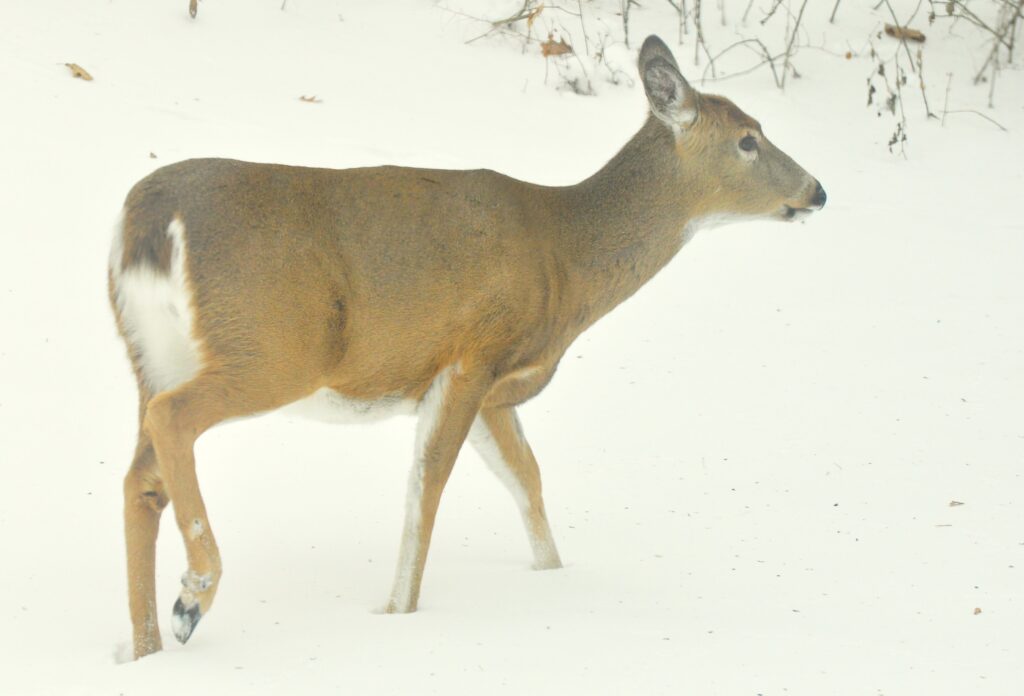Photography courtesy of Lowell Washburn, all rights reserved.
Popular, challenging, and nutritious, the white-tailed deer is one of Iowa’s most treasured natural resources. I love watching, hunting and, yes, consuming our nation’s most popular big game animal. But when Iowa’s deer seasons end in January, there is always one deer that I hope has survived another year. That deer is a beautiful doe that I call Bobtail.
I call her Bobtail because, at some point in her life, her tail was literally chopped in half. Although I’ll never know the actual cause, an early encounter with a fawn-hunting coyote seems a likely scenario. What is certain is that the squared off portion of the tail that remains makes Bobtail unmistakably easy to identify.
My first encounter with Bobtail came during the winter of 2017 when she, along with several other white-tails, leaped across the road in front of my truck at the Dave Rosendahl farm located just south of Clear Lake. I’ve enjoyed many additional sightings since that snowy day. I’ve learned that Bobtail’s home range runs at least four miles in length and includes both public and private landscapes.

Many sightings have been at a distance. Others have been more up close and personal measuring at distances of under ten yards. Included among my favorite observations are those when I’ve been able to view Bobtail with her latest set of twin fawns. Already an adult when I first spotted her in 2017, Bobtail has produced beautiful sets of twins every year since, and she may have raised additional fawns before we first crossed trails.
Even when I’m in desperate need of fresh venison, I never draw my bow on an antlerless deer until I’m sure the animal is not Bobtail. My decision is, I suppose, is an odd mix of science and emotion. From a biological perspective, adult does are the most important components of any given deer herd – as aptly demonstrated by the dozen [known] fawns that Bobtail has already produced. Simply put, deer herds ebb and flow by the number of does they contain and the number of fawns those does produce. On the emotional side, I wouldn’t harvest Bobtail because I “know her”. Might sound silly, I know. No basis in science, just the way I feel.
Following the conclusion of Iowa’s multifaceted 4 ½-month-long deer seasons, the suspense begins. Did Bobtail survive? Was she shot, hit by a car, or did she succumb to another of the many dangers that are a daily reality of life in the wild?

There are years when I don’t catch a glimpse of Bobtail until spring or even early summer. This year, the suspense ended early when, late last week, I spotted my favorite deer walking across a clean, snow covered clearing on the south side of Clear Lake. So far, so good. Come spring, I hope, once again, to see Bobtail watching over her latest set of twins.

 Susan Judkins Josten
Susan Judkins Josten Rudi Roeslein
Rudi Roeslein Elyssa McFarland
Elyssa McFarland Mark Langgin
Mark Langgin Adam Janke
Adam Janke Joe Henry
Joe Henry Sue Wilkinson
Sue Wilkinson Tom Cope
Tom Cope Kristin Ashenbrenner
Kristin Ashenbrenner Joe Wilkinson
Joe Wilkinson Dr. Tammy Mildenstein
Dr. Tammy Mildenstein Sean McMahon
Sean McMahon